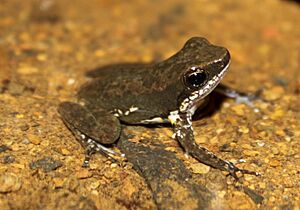Panama rocket frog facts for kids
Quick facts for kids Panama rocket frog |
|
|---|---|
 |
|
| Conservation status | |
| Scientific classification | |
| Synonyms | |
|
Hyloxalus panamansis Dunn, 1933 |
The Panama rocket frog (scientific name: Colostethus panamansis) is a small, colorful frog. It's a type of poison dart frog. You can find this frog in the rainforests of northwestern Colombia and Panama. Scientists have studied this frog a lot. For a long time, it was thought to be the same as another frog, Colostethus inguinalis, but now we know it's its own special species.
Contents
Where They Live
The Panama rocket frog lives in several areas of Panama. It also lives in Parque Nacional Natural Los Katios in Colombia. These frogs like to live near streams in forests. They prefer lowlands and hilly areas. You usually find them at elevations below 800 meters (about 2,600 feet).
What They Look Like and Their Life Cycle
Adult male Panama rocket frogs are about 19 to 27 millimeters long. That's less than an inch! Adult females are a bit bigger, measuring 25 to 29 millimeters.
The female frog lays her eggs among fallen leaves on the ground. When the tiny tadpoles hatch, she carries them on her back. She does this for up to nine days. Then, she finds a fast-flowing stream. She dips herself into the water, and the tadpoles swim off. They finish growing into frogs in the stream.
How Scientists Study Frog Health
Scientists use the Panama rocket frog to learn about diseases that affect frogs. One serious disease is called chytridiomycosis. It's caused by a tiny fungus named Batrachochytrium dendrobatidis. This fungus makes many tropical amphibians sick.
Scientists collected healthy rocket frogs from El Copé in Panama. They checked to make sure these frogs did not have the fungus. Then, they put some of the fungus on the frogs. Some of these frogs got sick and died. The scientists then found the same fungus in the sick frogs. This helped them prove that this fungus causes the disease.
Protecting the Panama Rocket Frog
The Panama rocket frog is listed as "Least Concern" by the IUCN Red List of Threatened Species. This means it's not in immediate danger of disappearing. It lives in many places and is quite common.
However, its population might be slowly shrinking. This is not happening fast enough to put it in a higher risk category right now. The main dangers to these frogs are deforestation (when forests are cut down). Other threats include logging and farming activities. Pollution from pesticides in streams also harms them.



